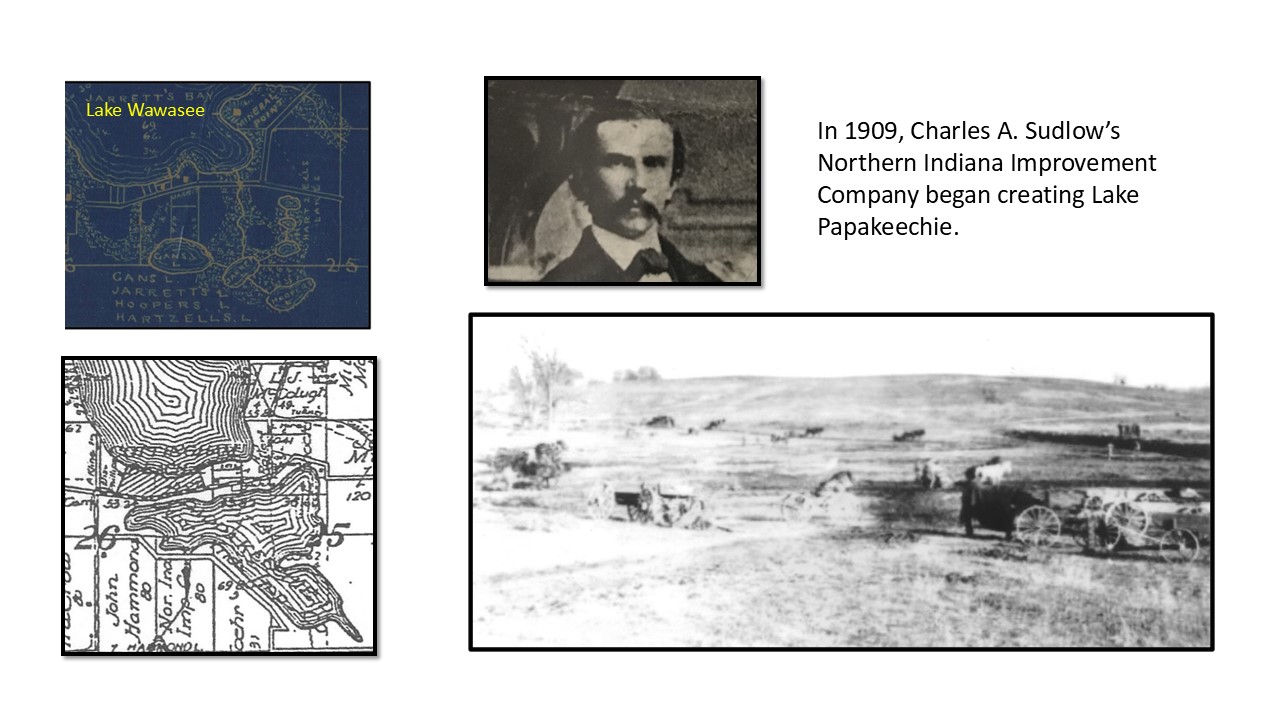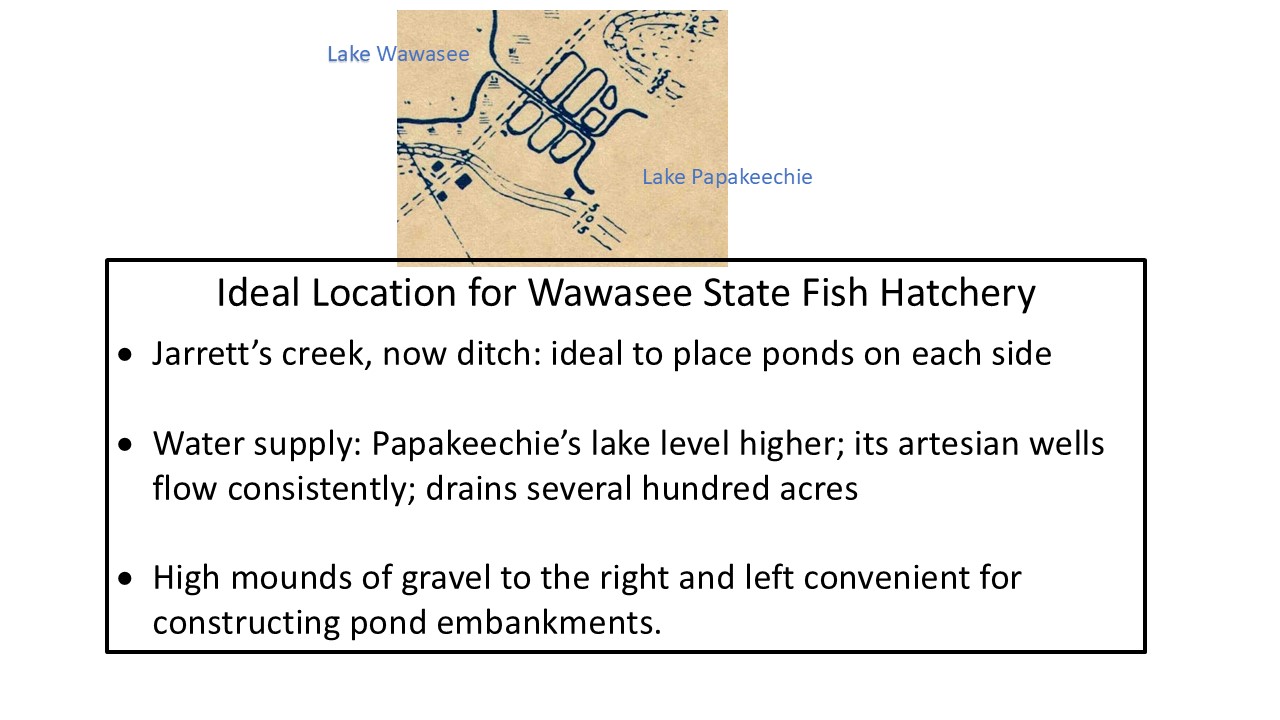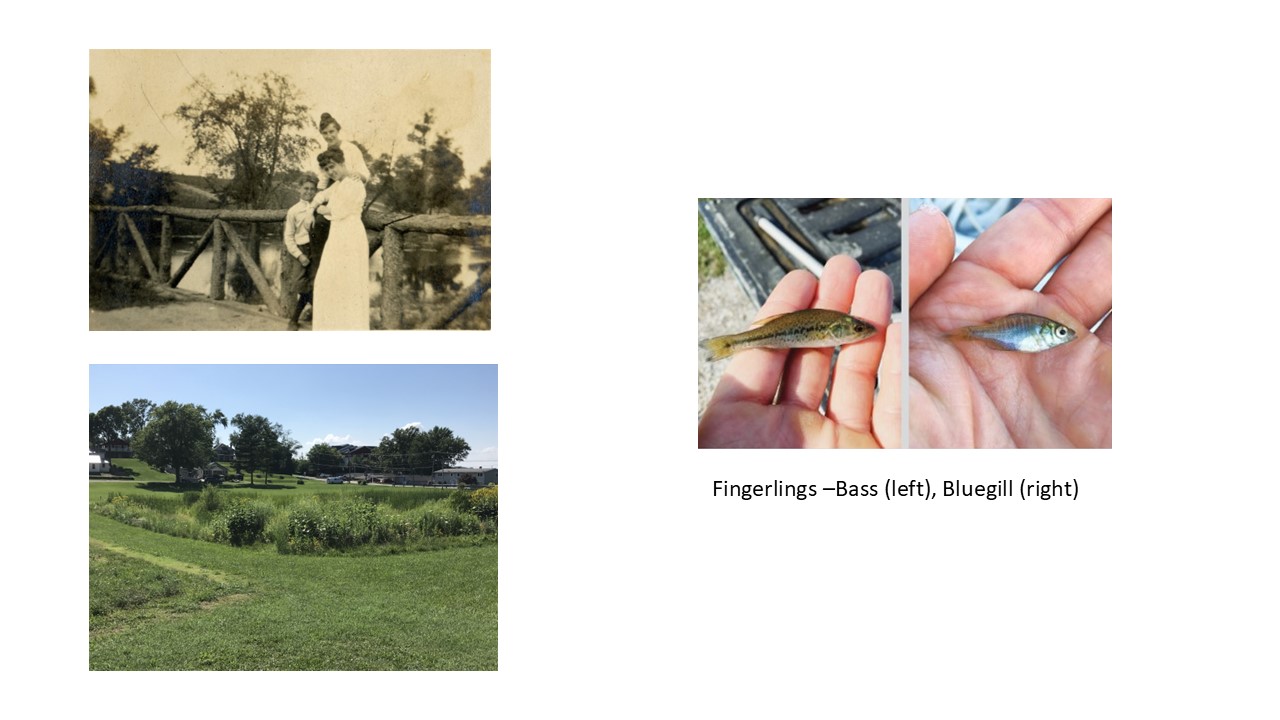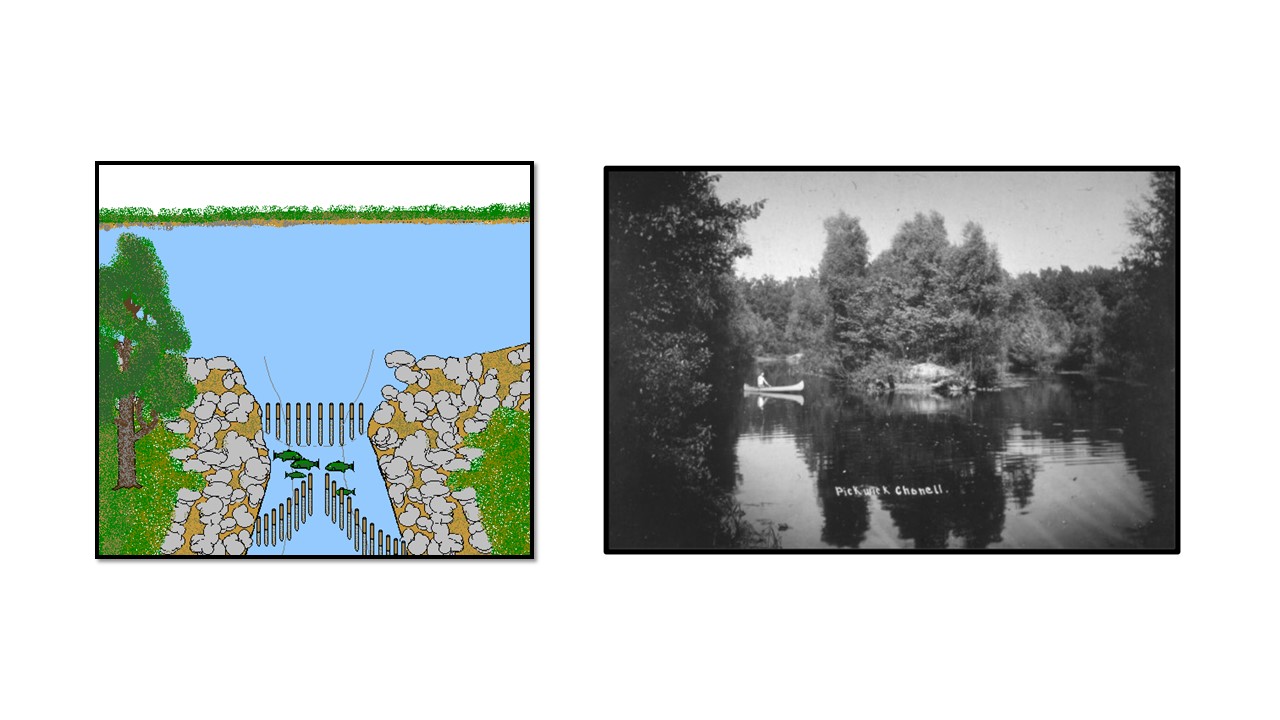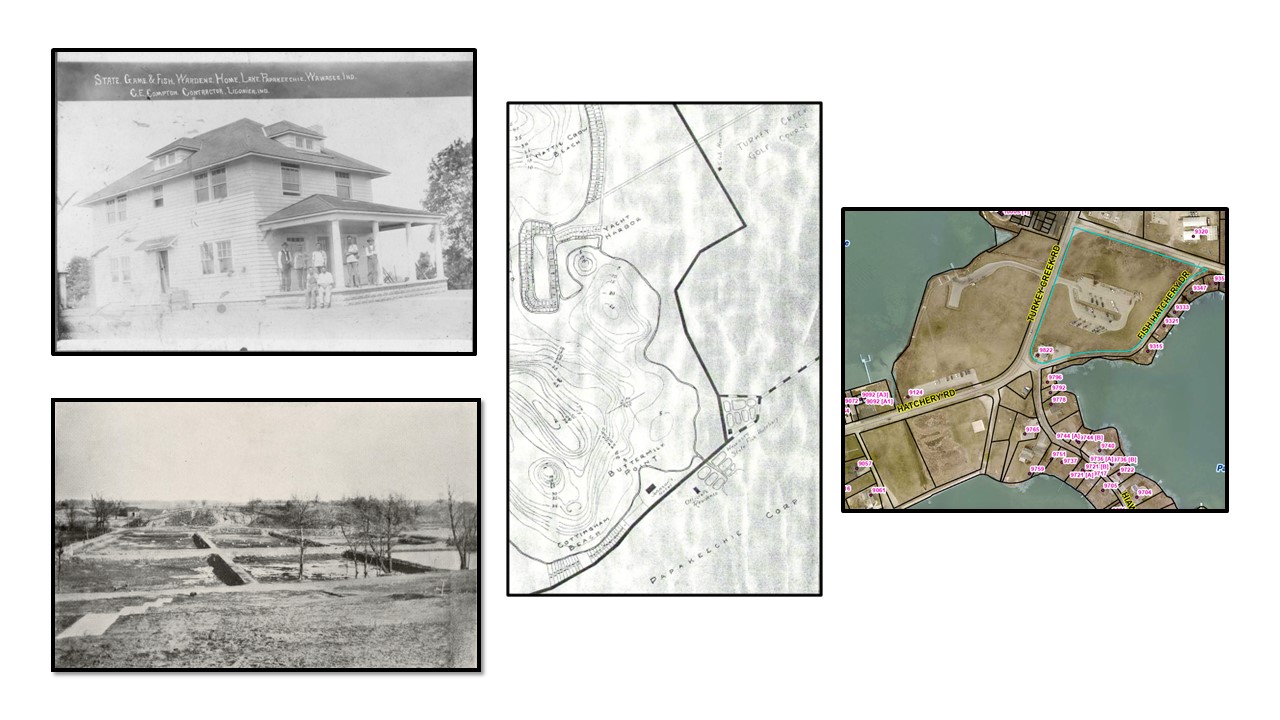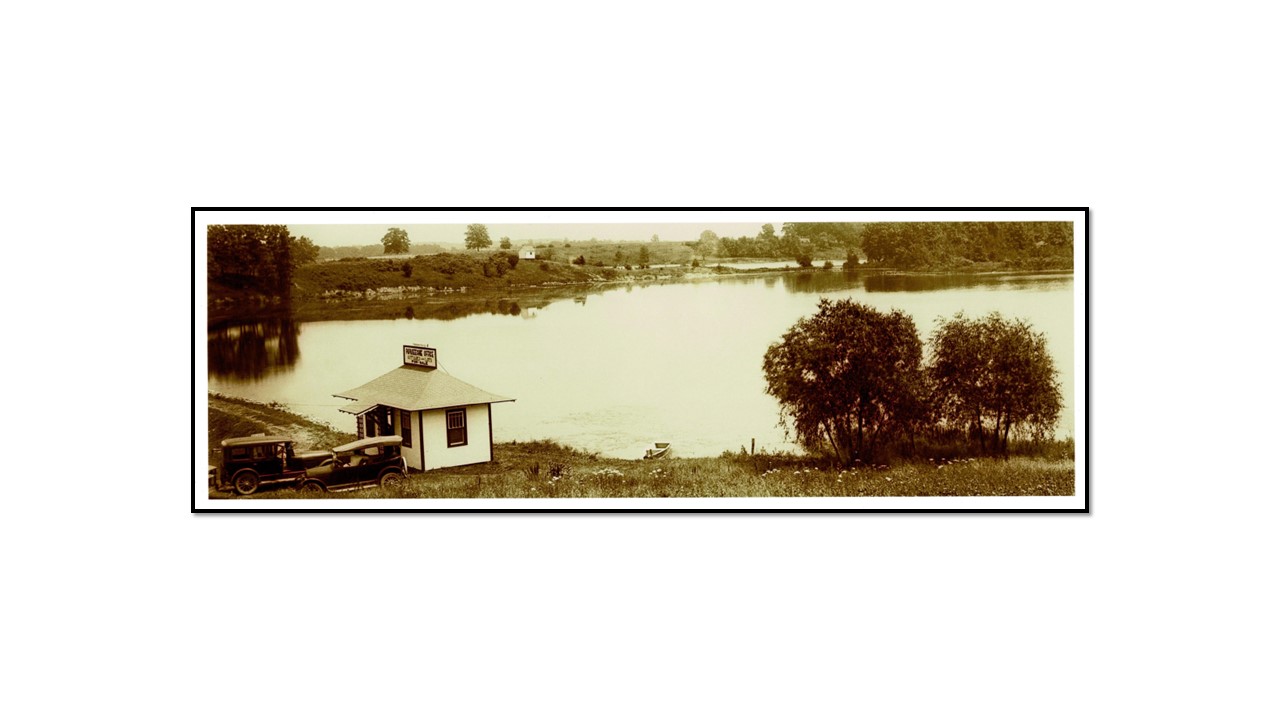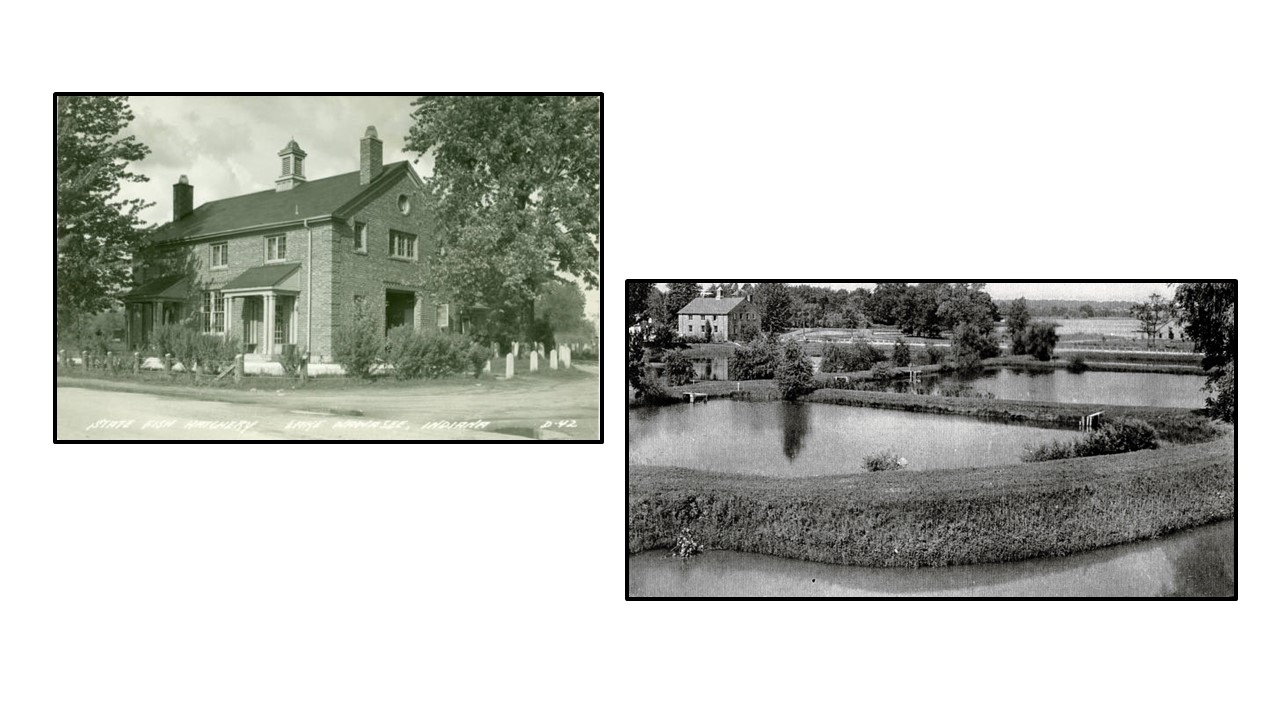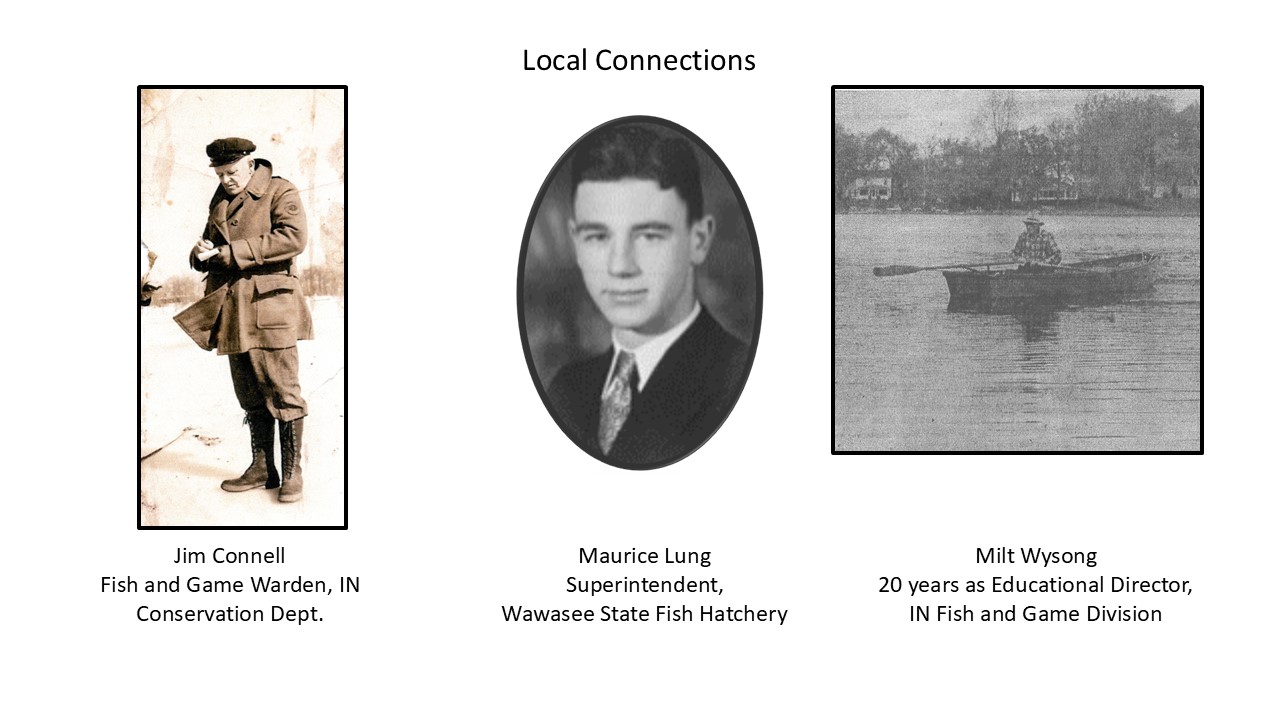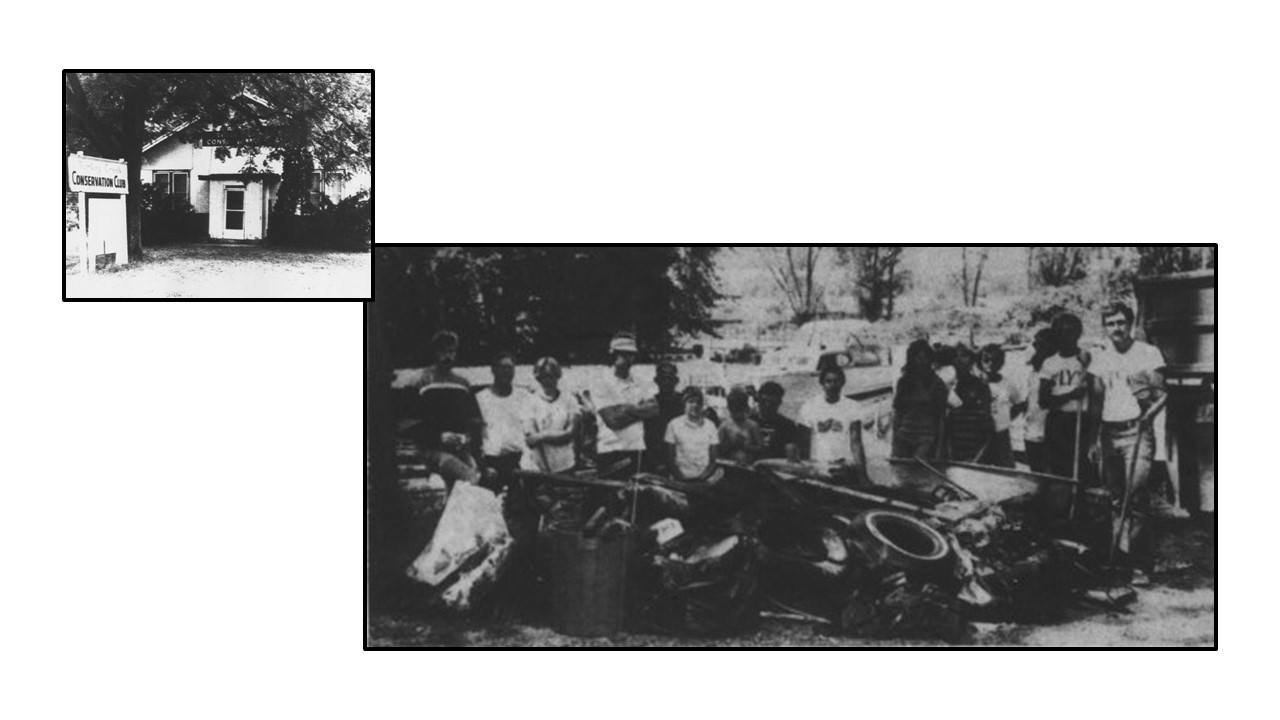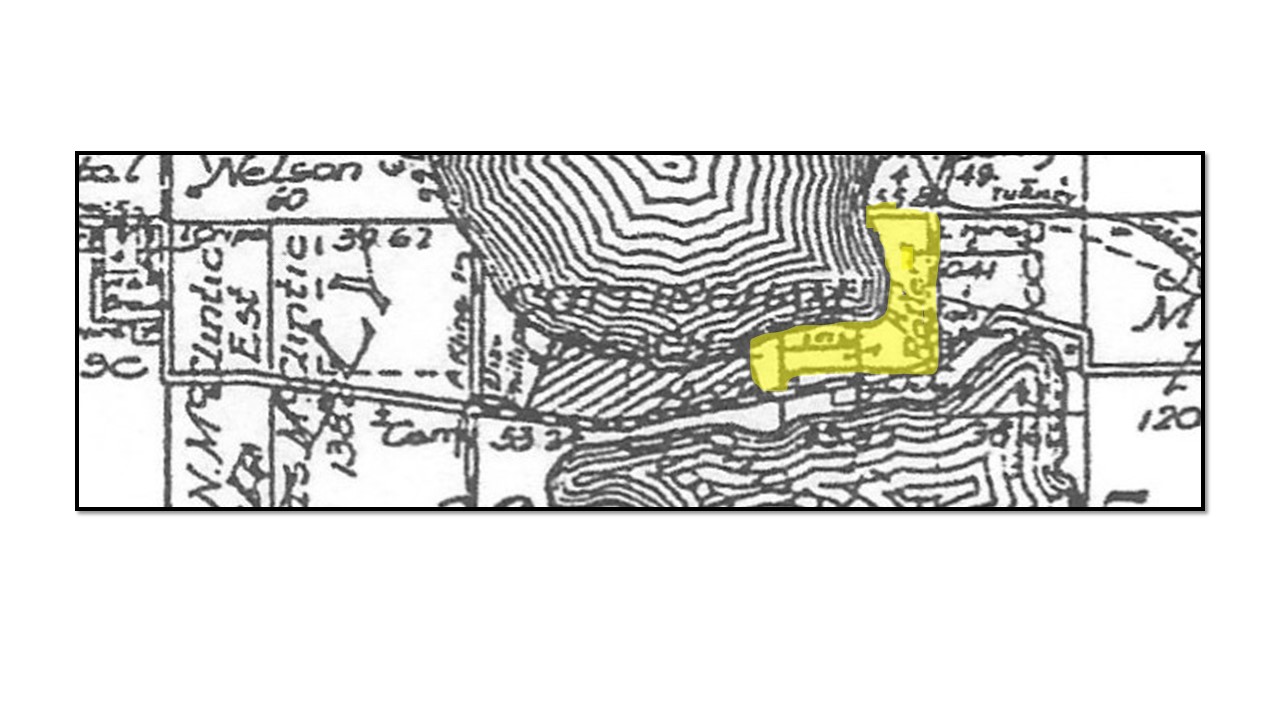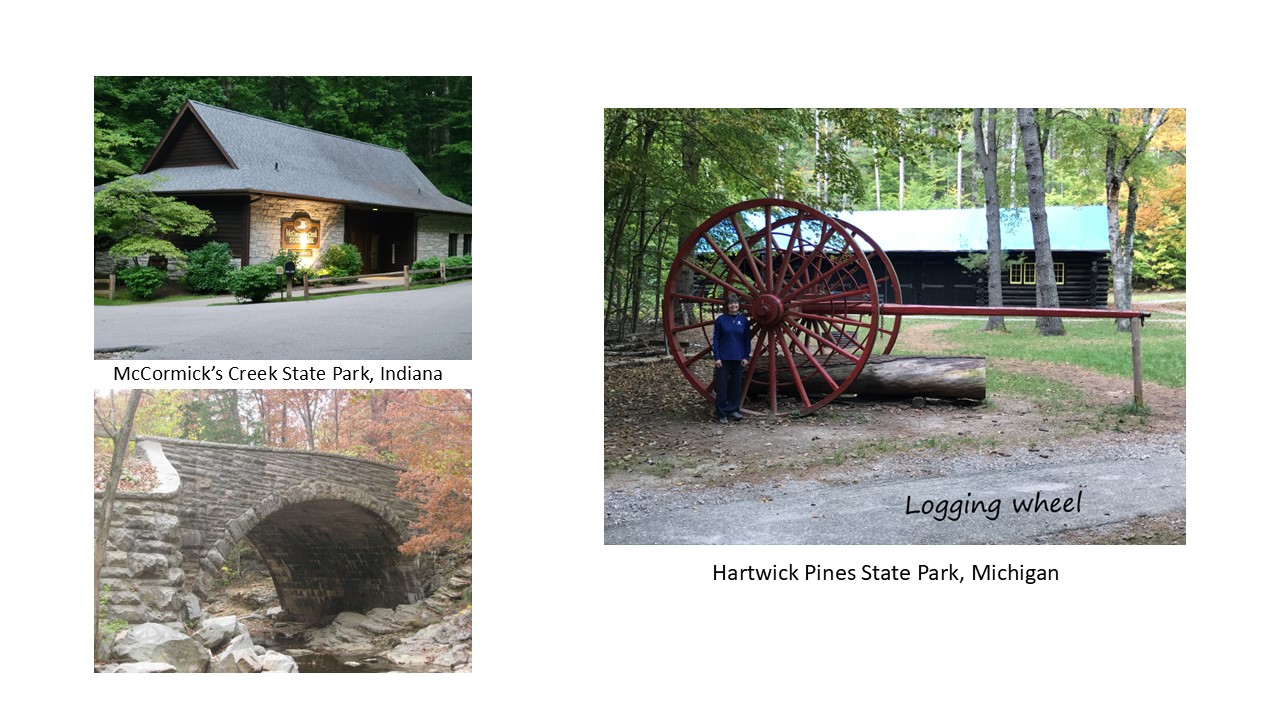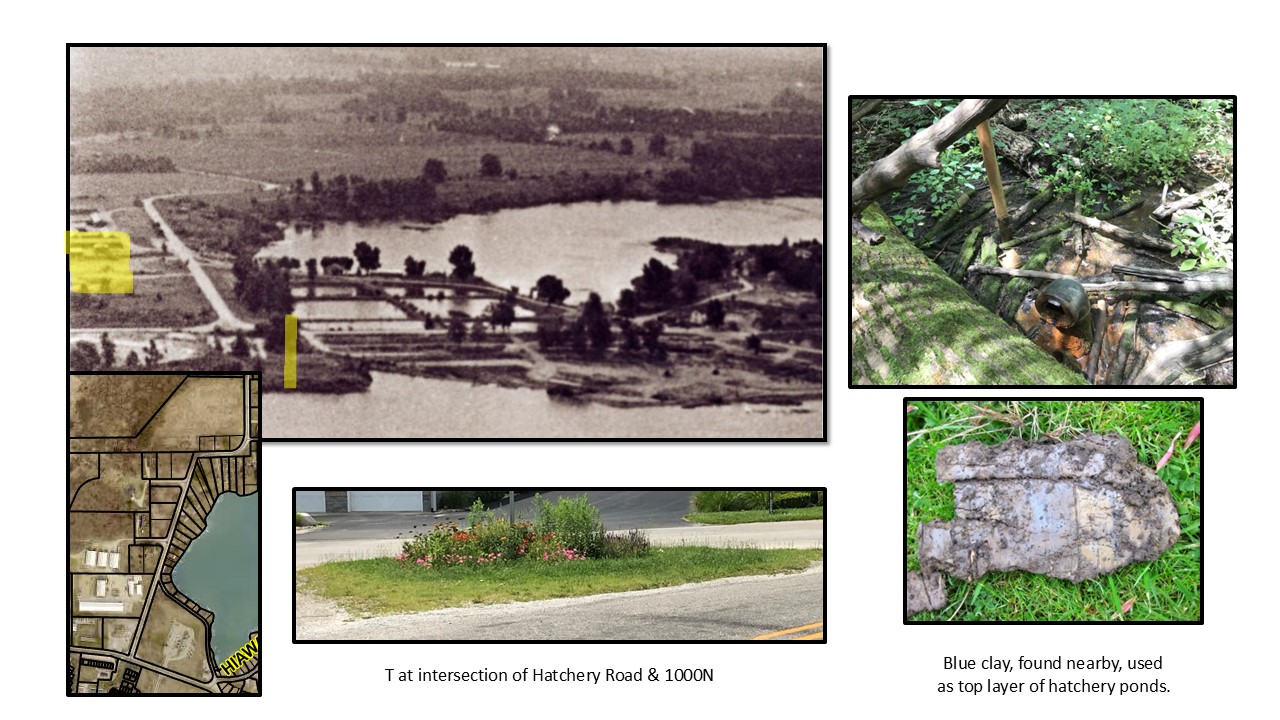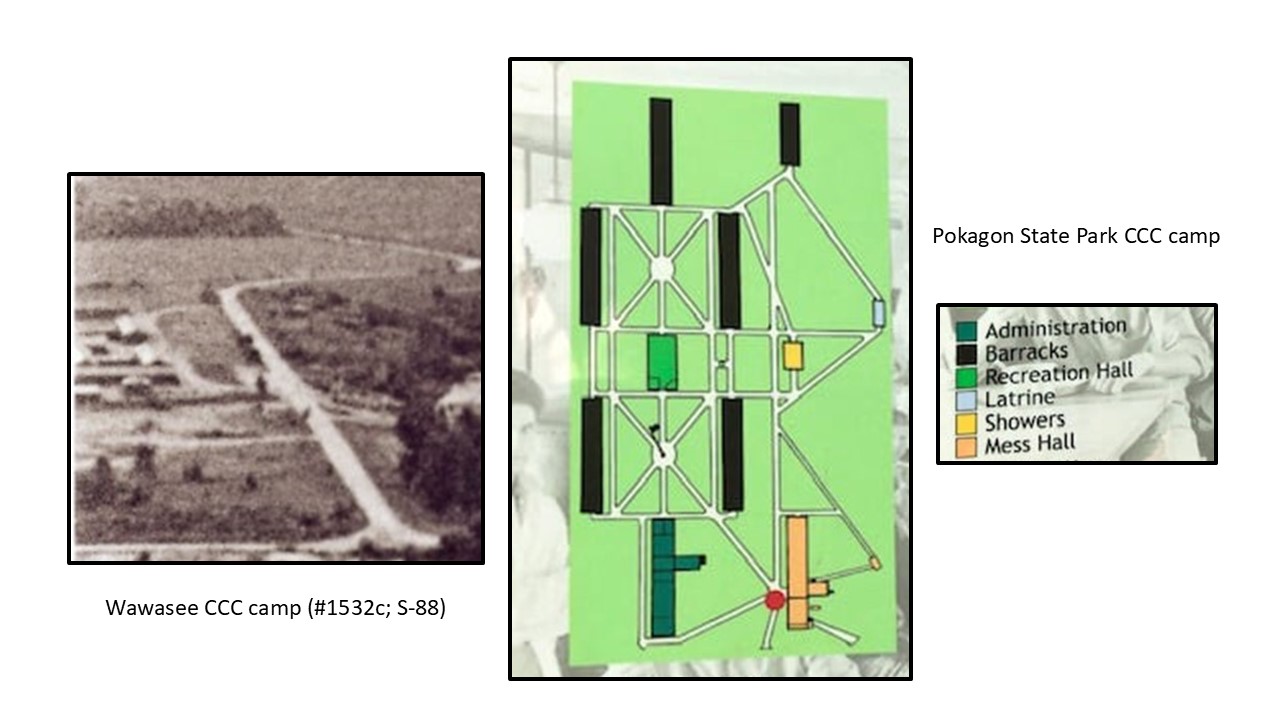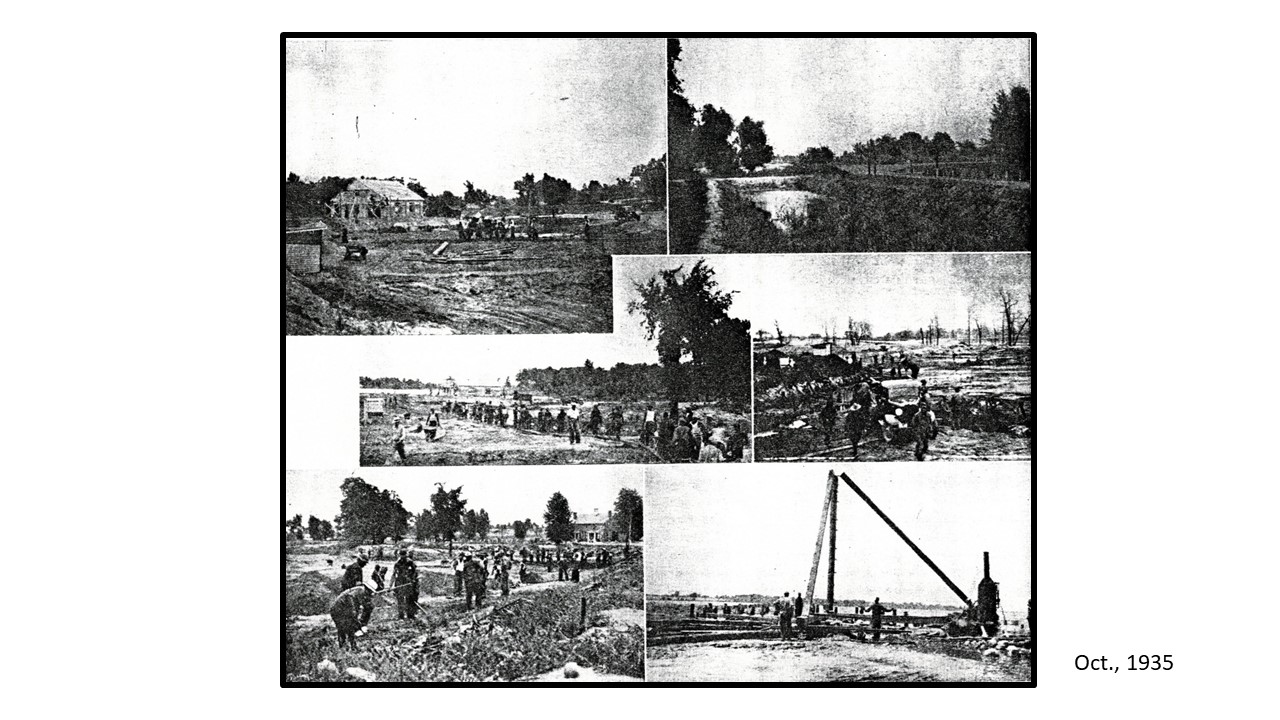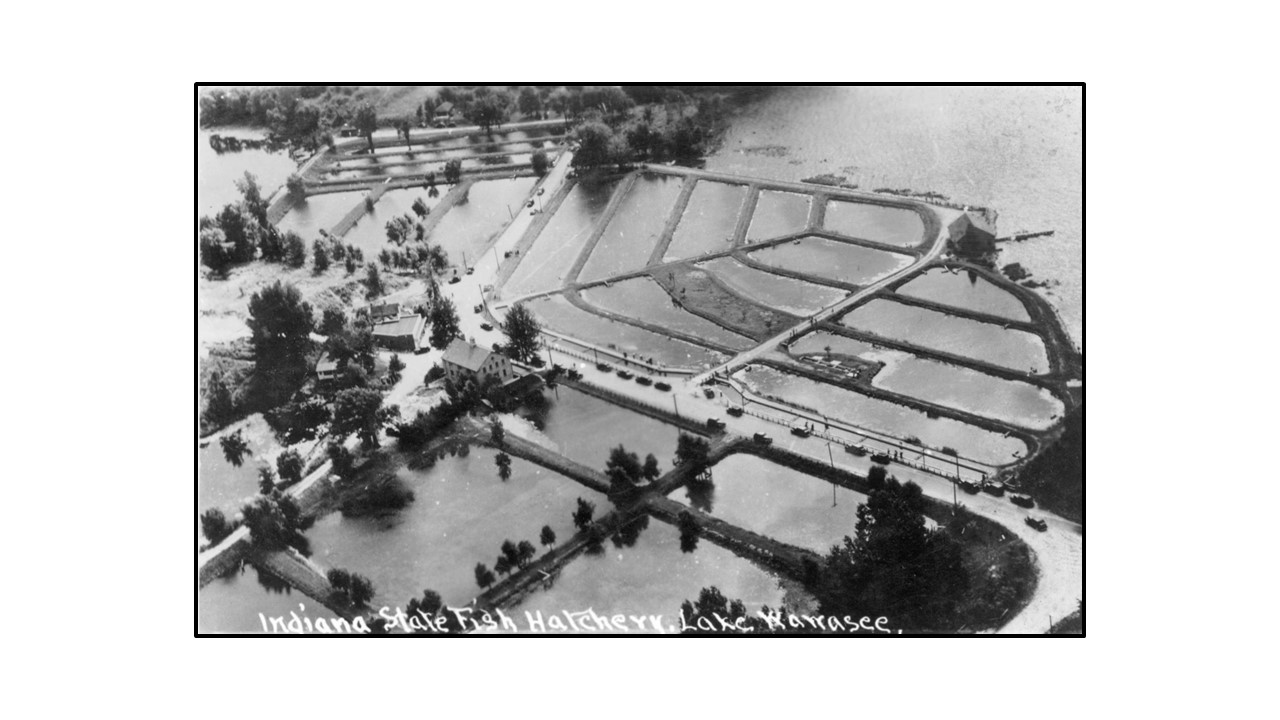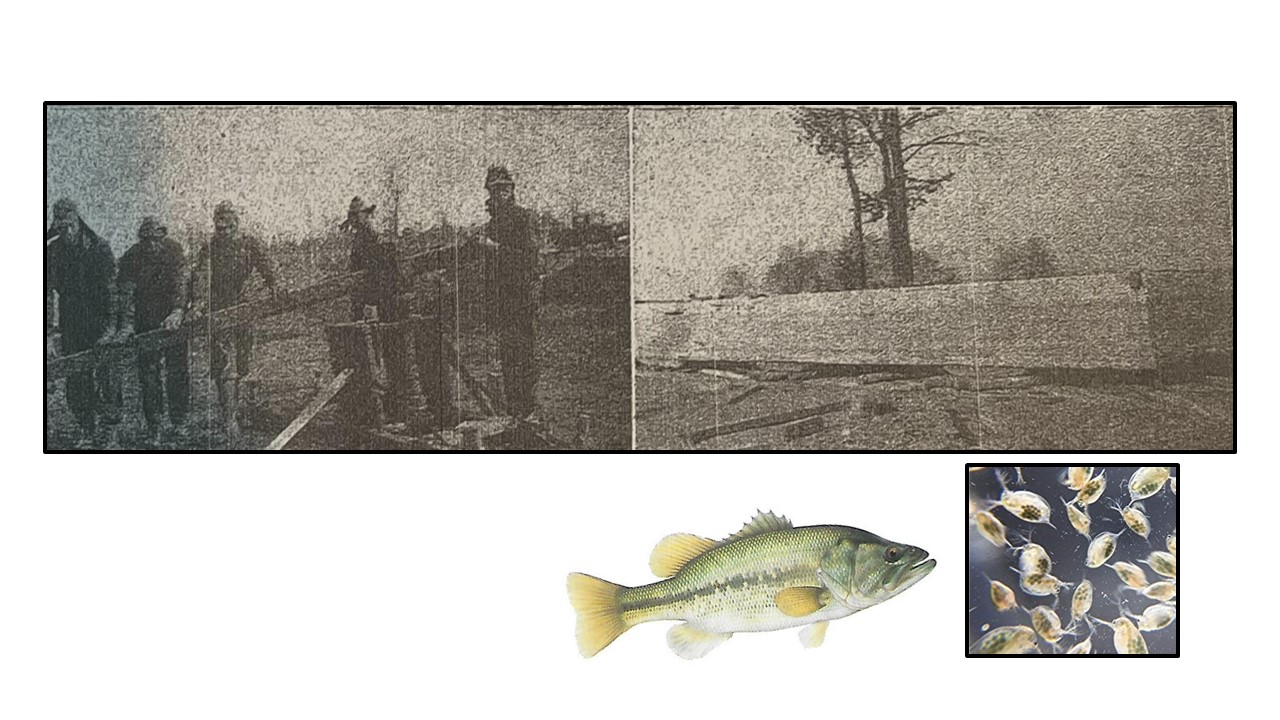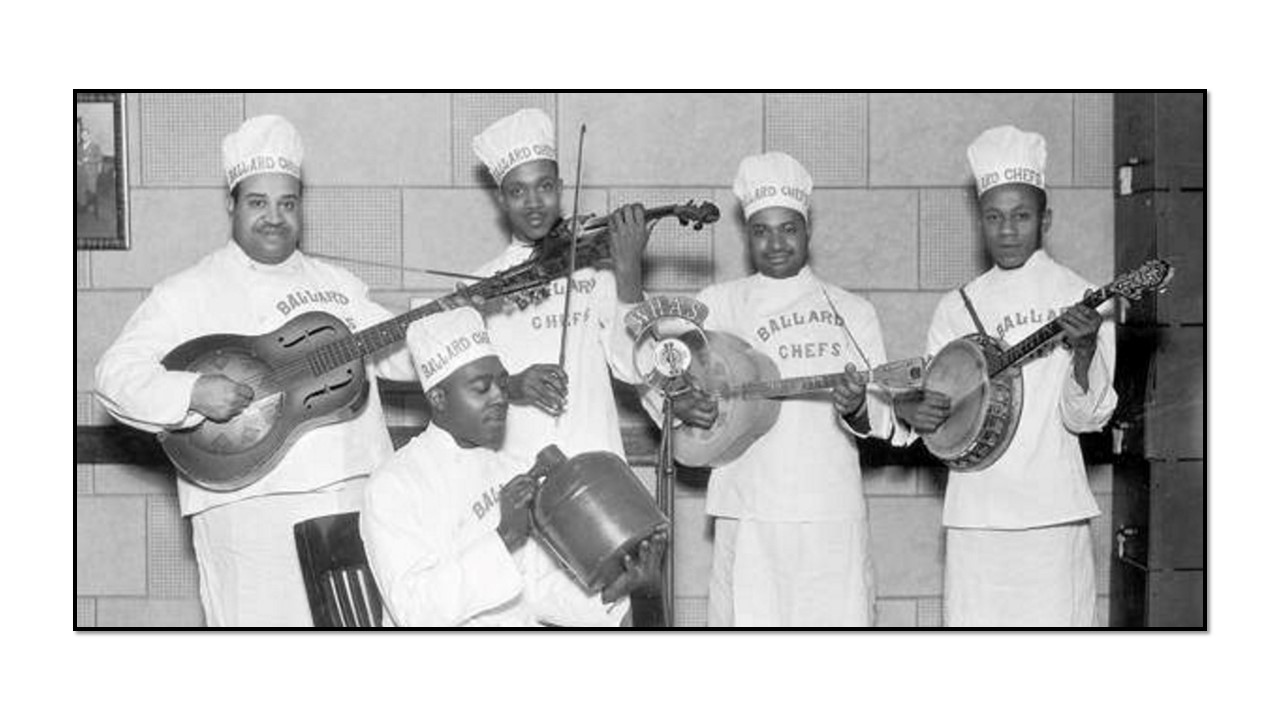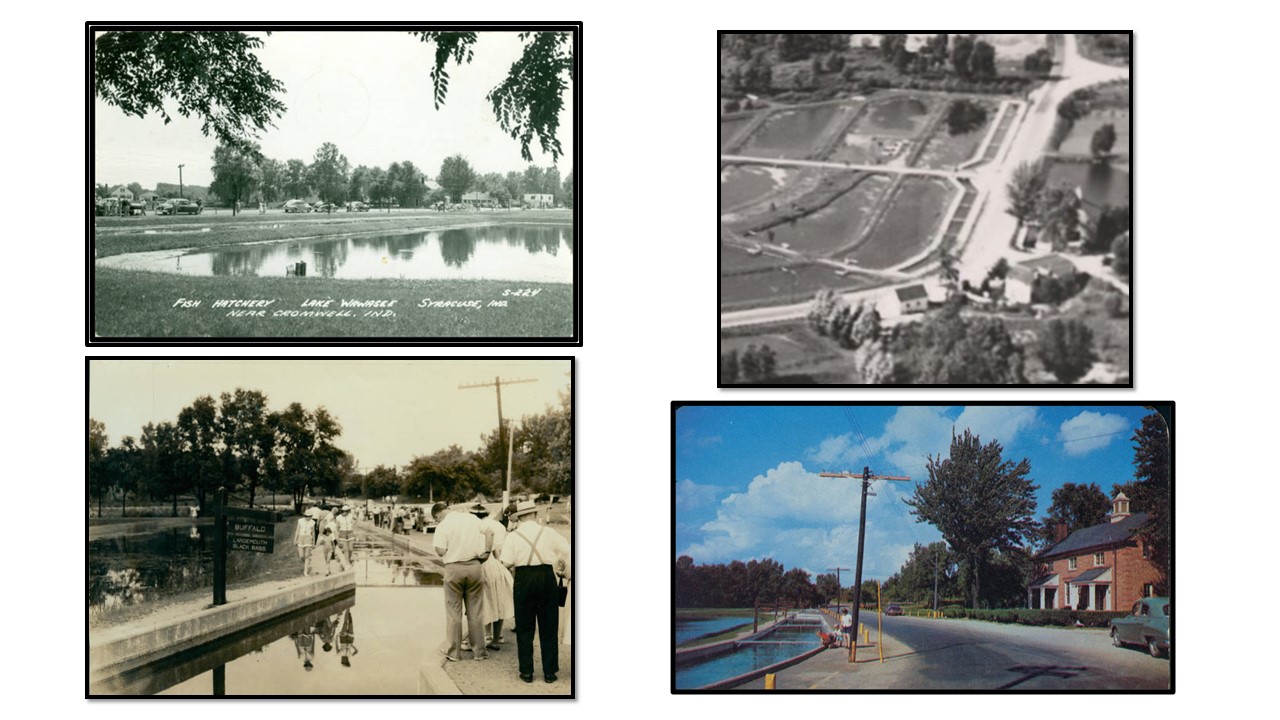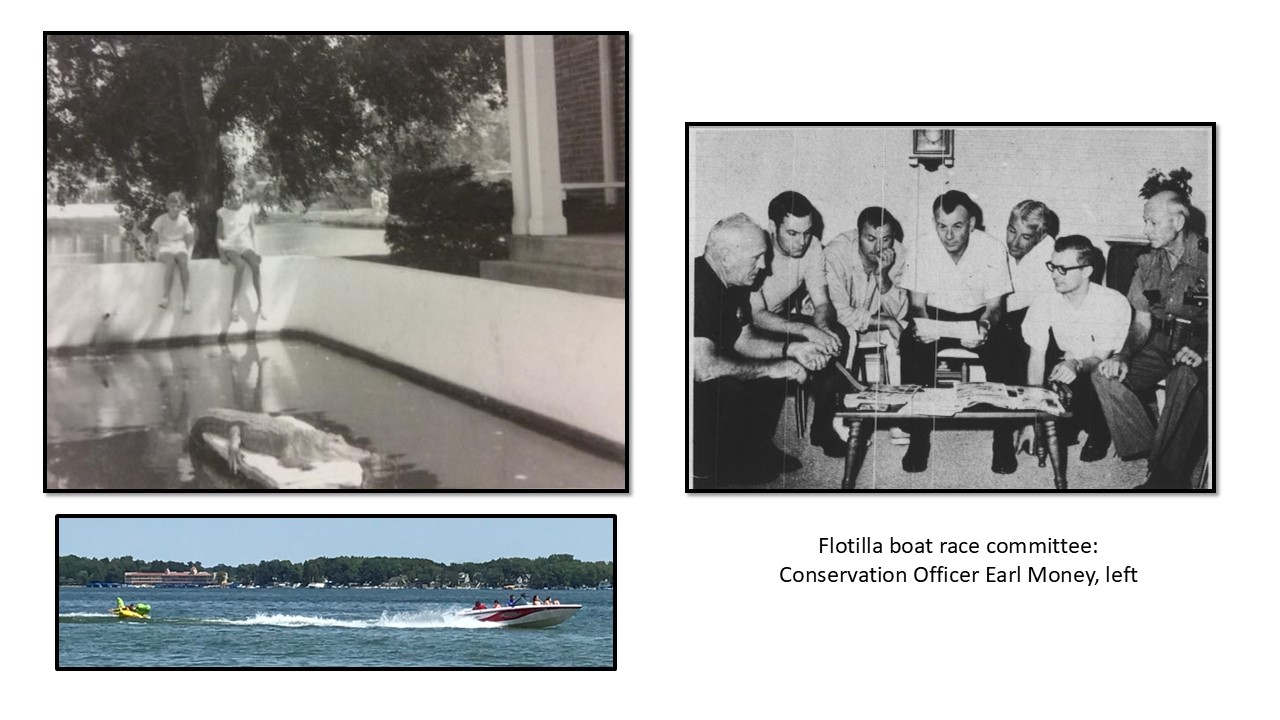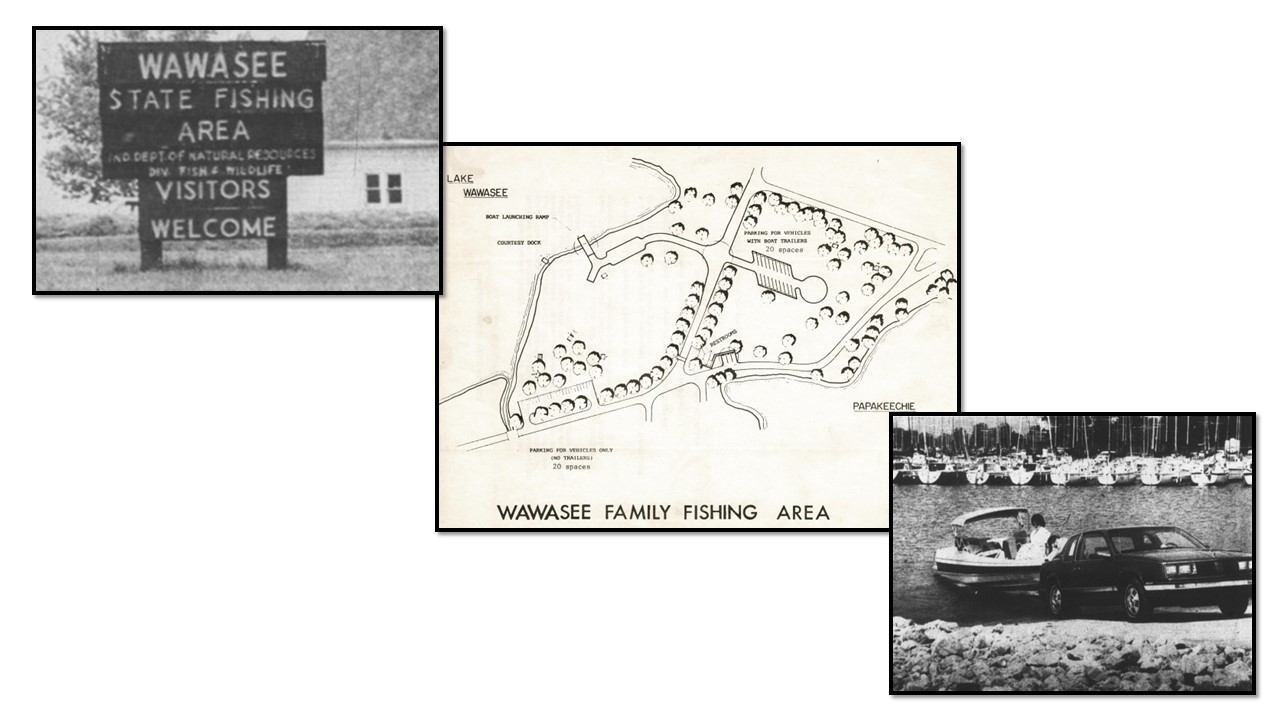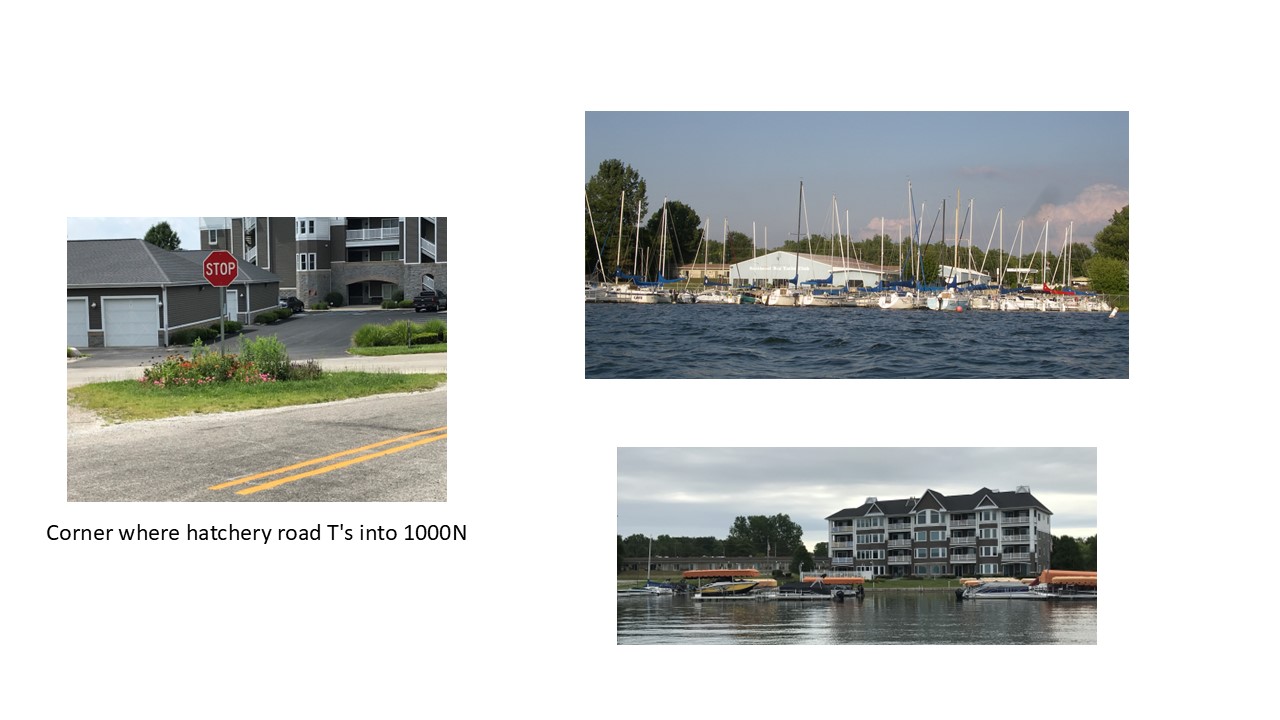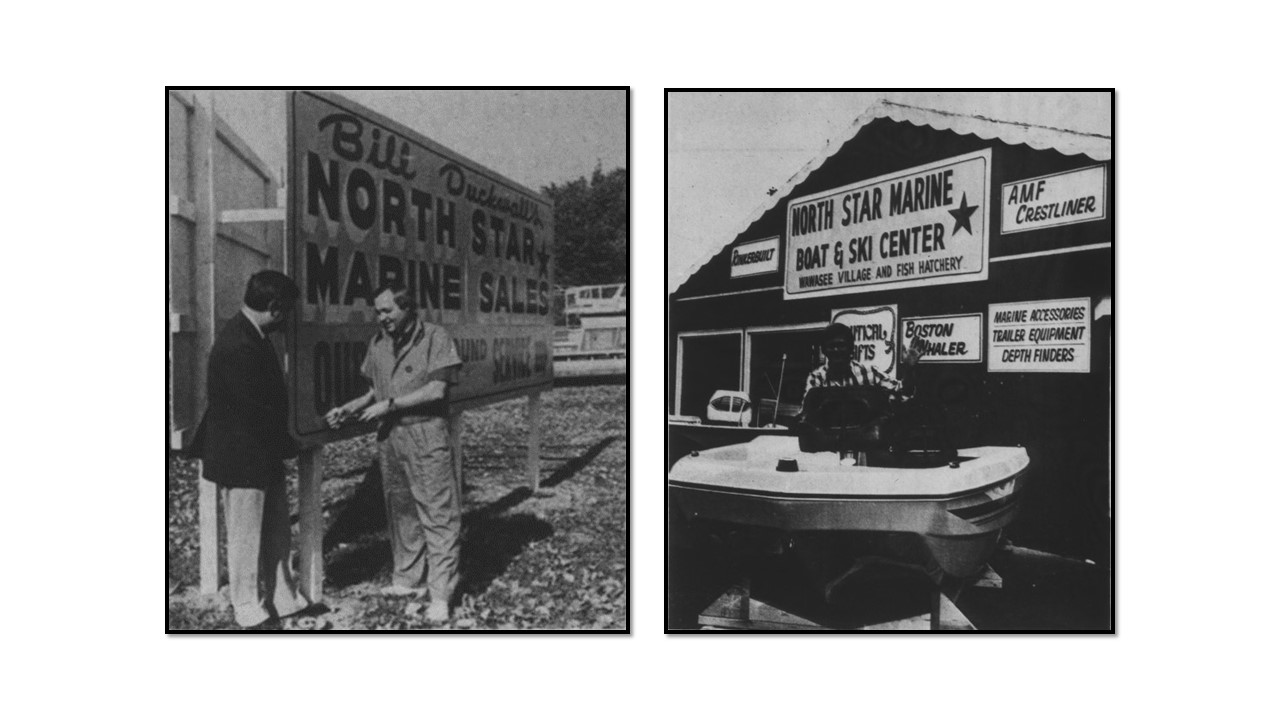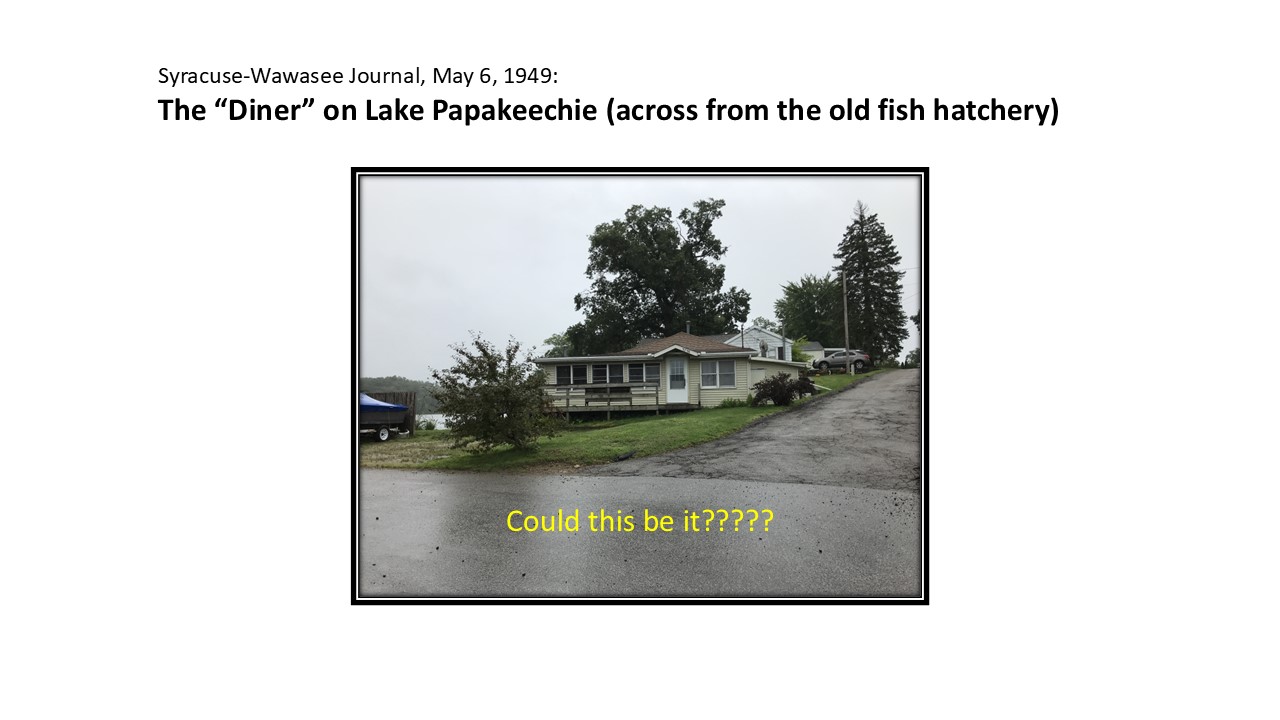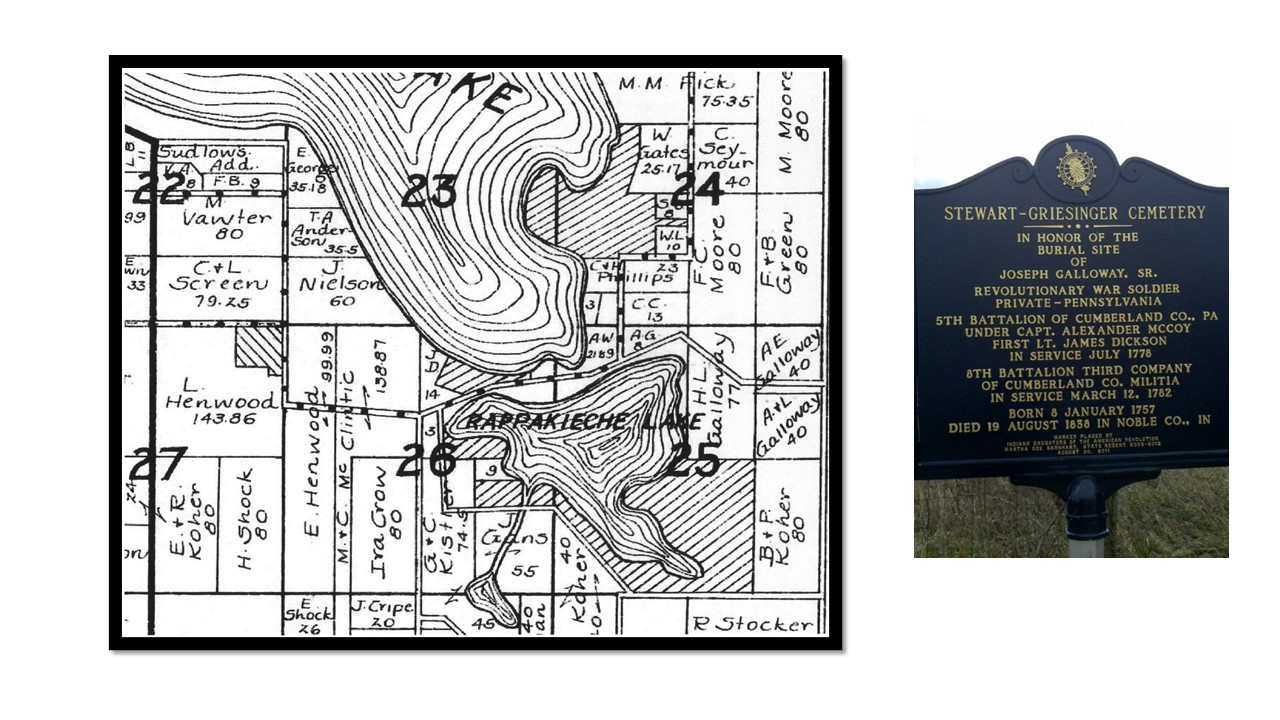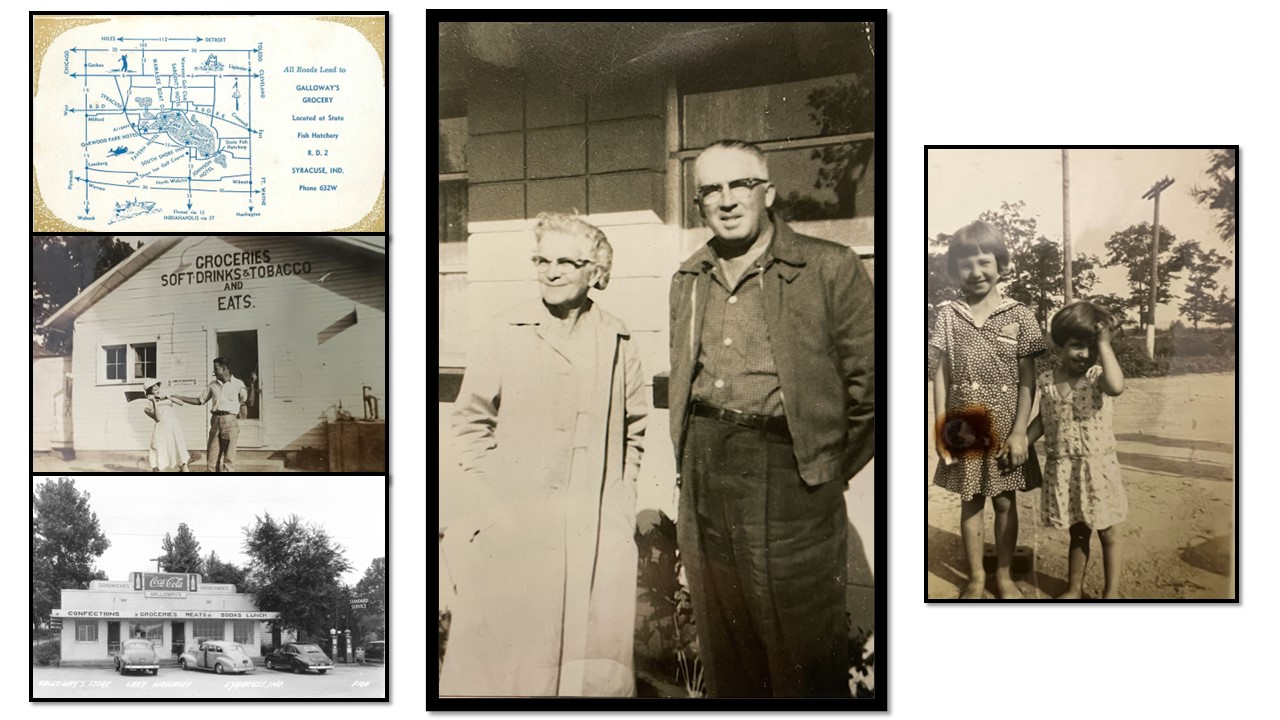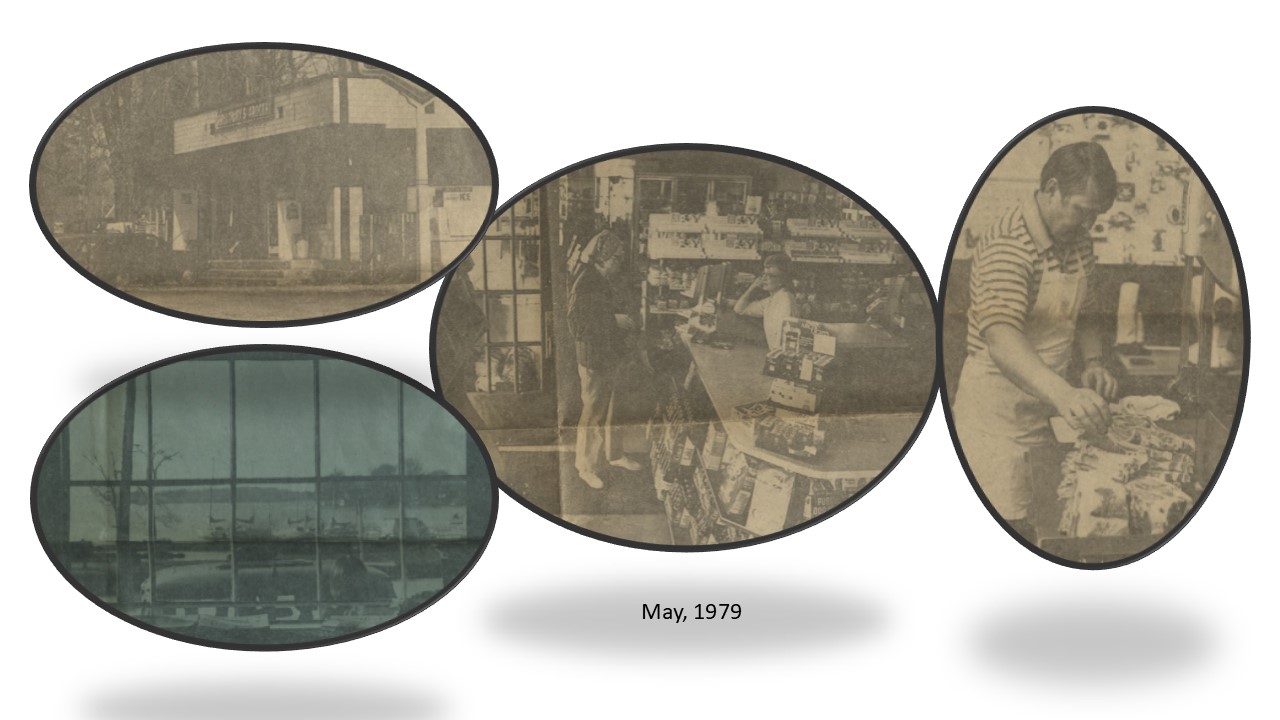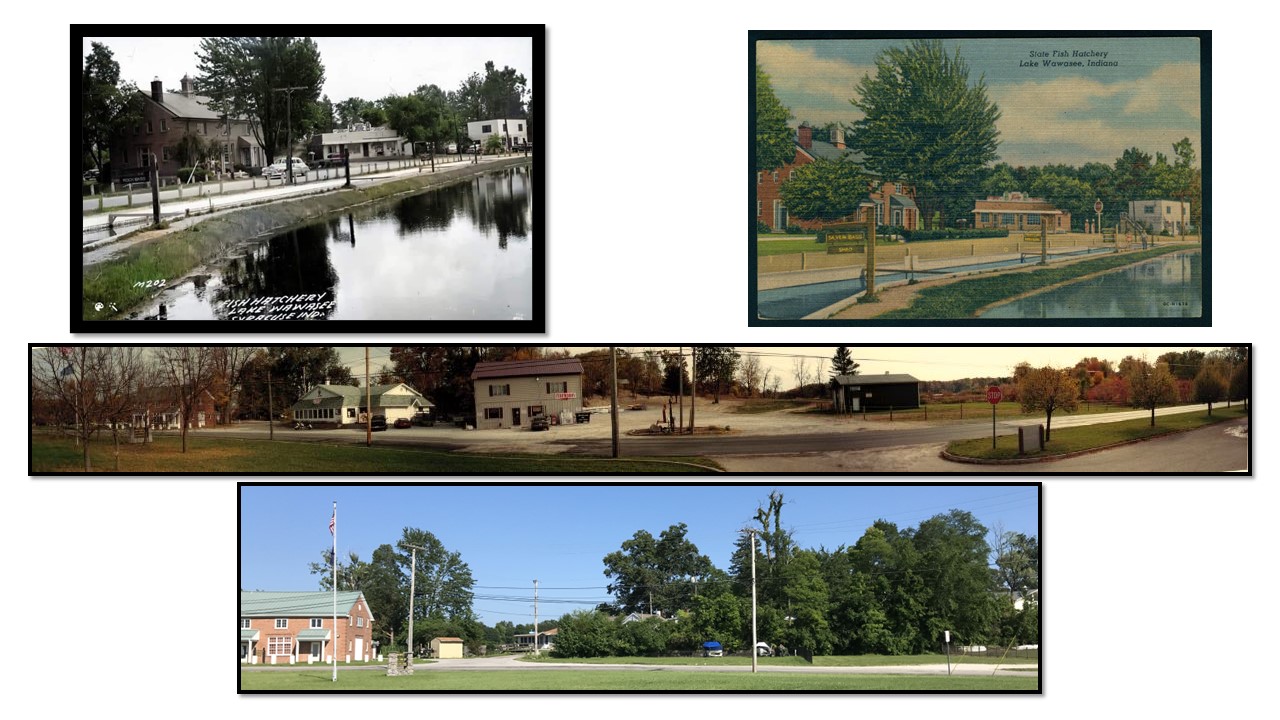The Fish Hatchery
A Centennial Presentation – August 12, 2023

Established 1920
From a news article in the Milford Mail Journal, Aug. 18, 1965: Five juveniles were apprehended Sunday for netting fish from the fish hatchery show ponds. Following a stern lecture, the boys were each instructed to write an essay explaining “why the state has fish hatcheries,” “what kind of fish they stock,” “how fish are raised,” and the “history of the Wawasee Fish Hatchery.” Essays were turned over to Conservation Officer Earl Money. Finding these “essays” would have made this presentation a lot easier!!!
In the early 1900s, just southeast of Lake Wawasee, was a valley containing six little lakes separated by low marsh lands which may have at one time been a single lake, the outlet being through small Jarrett’s creek into Wawasee. Charles A. Sudlow evolved a plan to restore this ancient lake. From October, 1909, through March, 1910, his Northern Indiana Improvement Co. constructed embankments and a dam across the valley’s several openings, raising the waters of those little lakes, making them into one – Lake Papakeechie.
The lake didn’t really fill up completely until it caught the snow melt and spring rains of 1911; the same year that Indiana established fish hatcheries. That June, Syracuse resident George Miles, the Indiana State Fish and Game Commissioner, paid a visit to the low land between the Papakeechie dam and the marshy shores of Lake Wawasee, finding an ideal location to raise game fish to stock the lakes in this area, something that had not been done for many years.
Mr. Sudlow gave the State perpetual rights to use the grounds as long as they were occupied by hatching ponds. In 1912, the first two ponds were built in time to raise young bass that were gotten elsewhere. By 1913, parent bass produced 68,000 “fingerlings” which were planted in lakes and streams in northern Indiana. More than 100 years later, you can still see evidence of the initial ponds of one of Indiana’s original five fish hatcheries.
It wasn’t the first “hatchery,” so to speak, on that site. Eli Lilly wrote, “Early in the 19th century there was a fish trap at the outlet of Jarrett’s creek into Wawasee. It was built of split stakes driven into the bottom, and the settlers would always find fish in it—unless the Indians got there first.” Around 1905, the first actual fish hatchery in Syracuse came into existence. The Wawasee Protective Association, with George Miles president, built a broodery in or near a small bay adjoining the canal at Pickwick Park. For 2 or 3 seasons, schools of bass fry were gathered from their beds in the lake and placed within the screened enclosure.
In 1914, the first enlargement of the Wawasee State Fish Hatchery (WSFH) took place: 8 large ponds were built on what is now the boat trailer parking lot, and the original ponds, too large to be efficient, were divided into 7 more ponds making 15 in all. In the fall of 1914, a custodian’s residence was built on the crest of the hill adjoining the west side. Ed Miles, George’s brother, apparently was the first hatchery superintendent. The state house also provided a stopping place for temporary personnel. Frequently today this house is referred to as the Governor’s House. My research has only found Lt. Governor Clifford Townsend spending some time there while enjoying fishing on the lake in 1935, and subsequently, as governor, opening the fishing season in 1937.
In 1915, the Papakeechie project ended with the untimely death of Charles Sudlow. The property remained dormant for six years, until the Northern Indiana Improvement Company sold it to Thomas Jefferson Prickett of Nappanee, who 4 months later in Dec., 1921, sold to the recently formed Papakeechie Corporation which sub-divided the property into building lots.
The brick headquarters building, which originally had a residence upstairs for the hatchery superintendent, was constructed in 1928, the last of this type built by the state. Hatchery activities took place on the first floor; stop by the museum to see the display case explaining the fish life cycle. The building was renovated in 1970 to house the offices of the conservation department’s post and again in 1992 to become headquarters for the District One Law Enforcement Division of the IN Department of Natural Resources.
This seems to be a good spot to include a few local men connected to this presentation whose descendants still live in the area. Jim Connell, a long-time Fish and Game Warden, was at various times stationed at the WSFH. His wife’s father, E.E. Miles, was most likely the first superintendent of the hatchery. In 1933, Maurice Lung went to work at the hatchery just after graduating from Syracuse High School. As a bachelor, he lived in the apartment above the headquarters building for four years, learning everything about raising fish and stocking lakes. In 1938, he married Lucille Mellinger, and they lived in the State House on the hill. Lung had been Superintendent of the Wawasee Fish Hatchery for 10 years, when in January, 1949, he was appointed supervisor of all state fish hatcheries, a position he had held for 2 years in the early 1940s before serving in the Marines for 3 years during WWII. The position required living in Indianapolis, but he was not fond of the city or politics so he returned to Syracuse to work and raise their daughter, Diana. Time was, if someone asked, “Who is one of the best fishermen around these parts?” Milt Wysong’s name would probably come up. For 20 years, he was the educational director of the Indiana State Fish and Game Division. A popular lecturer on the life and habits of fish, Wysong became known as the “Daddy” of the state’s conservation clubs, organizing hundreds of them around the state. (SHOW BOOK) He authored “The Hoosier Fisherman,” which quickly sold out! He may have also tuned your piano.
Here are some fascinating pictures taken in the local area, shared by Mike Harris and a new contact at the DNR who is looking forward to reading the information we’ve gathered.
The Wawasee Conservation Club, newly organized in 1934, raised bass for a couple years in two fish rearing ponds built in back of the Syracuse power house, between the race and Skinner ditch. They sold fingerlings to the Dept. of Conservation. The group disbanded in 1951. The Turkey Creek Conservation Club was popular in the 1940s and ‘50s and then reactivated in the late ‘60’s and ‘70’s. You may remember their club house on the east side of Wawasee north of Lakeside Chapel. A big club project for about 3 or 4 years was trash clean up in the shallow areas of Johnson’s Bay.
In Nov., 1930, responding to area residents’ requests that the hatchery be updated and enlarged, the conservation department bought land from the A. J. Rollert family who owned everything along the lake shore from the mouth of Turkey Creek to the Johnson’s Hotel/Heil’s Haven area. Local workers did a lot of refurbishing to the existing hatchery.
These structures in IN & MI state parks are examples of the work of the Civilian Conservation Corps (the CCC), a voluntary work relief program created in 1933 during the Depression, by Pres. Franklin D. Roosevelt’s New Deal to provide jobs for unemployed, single young men. Clad in khaki, the enrollees lived in work camps, gaining valuable job skills and the opportunity to receive high school diplomas. They were paid a base salary of $30-$45 per month, most of which was sent home to their families. There were fifty-six CCC companies in the state of Indiana.
Near Lake Wawasee, one of eight African-American CCC camps in Indiana was established in mid-August, 1934, to work on improvements and expansion of the fish hatchery. Equipped to house 245 young men, the 13-acre camp was situated on the hill behind what is now the boat parking area near Hatchery Road at the T with CR 1000 N; finding concrete pads & an artesian well at Hursey’s Boat Storage just confirms the location. This property was the likely source of at least part of the blue clay used to do the finish lining of the fish ponds. The aerial was taken around 1934 by the Herdrich family.
This diagram shows a typical layout of a camp. At Pokagon State Park, you can still see the outlines of the original buildings and visit the CCC pocket museum. The site of the Wawasee camp was a mass of weeds standing at least five feet high which took three days of cutting and pulling to make it habitable. Large tents were erected to house the workers while they built the camp, which consisted of: five (later 6) barracks; a mess hall, recreation hall, officers’ quarters, bath house, artesian well & sewage disposal system. A month and a half later, September 30, 1934, the camp was considered built.
Work could then begin on the enlargement of the hatchery, “in the wilds” along the shore of Lake Wawasee. Weeds over a man’s head had to be cut before engineers could get in to survey and lay plans. A lagoon ran through the marshy area between the road and the lake, demanding boots – snakes of all kinds were plentiful. Muck, in some places more than fifteen feet deep, had to be removed before the ponds could be constructed.
As one of the largest CCC projects in Indiana, the expansion of the WSFH included 13 new ponds on the north side of Hatchery Road (doubling the water area) and a combination boat house and pumping station (on pilings driven 20 feet into the muck to reach solid ground). When completed, the entire hatchery had 27 ponds. Amazingly, new construction did not interfere with ongoing hatchery activity. The WSFH was within a pond or two of being the largest hatchery in Indiana.
The fish, for their own health, were fed every other day crawfish, minnows, and Daphnia bugs which are small freshwater “water fleas” named for their jerky, hopping movements. A remarkable CCC feat was the moving of a 30-ton concrete daphnia tank about 75 feet – totally by man’s ingenuity!
All was not backbreaking work: a group from the camp (similar to this one) entertained at the 1936 North Webster Alumni Banquet – their program included a jug band, singers, a shuffle dancer and a tap dancer. In their off time, the men kept busy with an extensive educational program, weekly informative movies or speakers, church services and Bible study. The camp published a newspaper, the Wawasee Bugle; they won the CCC state track meet in June, 1935 and presented a minstrel show in Syracuse to a crowd of around 800.
The WSFH CCC project was completed in mid-June, 1937. Maurice Lung, hatchery supervisor, based his predictions for a record year on the July 4th attendance of over 10,000. The CCC-built concrete display ponds were one of the most popular attractions from April to October. In addition to the common fish in the lake, there were memorable ones like the spoonbill catfish and the long-nosed gar. Our former museum director, Eloise Kuhn, was pretty sure she was in this picture.
I couldn’t give this presentation without talking about “Alberta” (picture compliments of Facebook). In front of the headquarters, a tank held turtles and a three-legged alligator (which, compliments of the local boys, didn’t always stay in the tank! In June, 1965, a local mother asked her kids, “What have you been doing?” They answered, “Playing with an alligator.” She immediately called the DNR. Conservation Officer Earl Money, along with a couple of other men, “wrestled” and captured Alberta in one of the canals near Anglers’ Cove at the back of Ogden Island.) I couldn’t resist sharing these kids enjoying a ride on this recently spotted alligator!
The hatchery closed in the mid-1960s; was transferred to the division of state parks in 1967, and, on June 20, 1970, the Wawasee Recreation and Fish area was dedicated. The local newspaper reported, “A short time ago, the area was nothing but a weed patch. Today it is a place to be proud of again. The concrete public display tanks have been cleaned and stocked with fish. Two ponds have been stocked, and those under 16 are allowed to fish from their banks. The grounds hosted events like ski shows and fireworks in the 1980s. The Wawasee Family Fishing Area opened in Aug., 1988. Workers filled in the hatchery ponds and created what we see today. Jim Ridenour, director of the Indiana Department of (Natural) Resources at the time, commented, “I want to keep the area as the “last unobstructed view of the lake.”
At its height, WSFH ponds were located along the shoreline in the large expanse of grass and the boat ramp area; in what is now the boat trailer parking area and from the Papakeechie Community Building to the other side of the spillway from Lake Papakeechie to Wawasee.
Let’s end my portion with a tour of the businesses that grew up in the fish hatchery area. Before I go much further, I’d like to thank Amy Hurd, at the Kosciusko Co. Surveyor’s office, for researching property transfers and museum board member Mike Mock for sharing his HUGE collection of information!!! Hoosier State Chronicles and IN Memory on the internet helped immensely with newspaper research and pictures, but the most enjoyable times were spent talking with a lot of wonderful people who freely shared their memories and pictures! In Oct., 1952, the Rollert family was clearing land to build Bushy’s Snackery in the lakeside area at the T past the fish hatchery. Bushy’s was famous for Key Lime pie. Later it was renovated to become the Wawasee Plaza Restaurant, and the Wawasee Plaza Marina & Motel was built. In the early 1980’s, Doug Anderson bought the business, naming it Southeast Bay Marina. The building came down in 2007-08 in preparation to build Sunset Condos. Across the road was the Fish Hatchery Branch of the State Bank of Syracuse built in Jan., 1975; closing in Sept., 1992. It was turned into a gas station (around back, you can still see the old drive-up window). Master Gardener Arlene Corson tends the triangle at the intersection.
North Star Marine Sales, Bill Duckwall, owner, was in business next to the fish hatchery from 1977 thru 1982, according to newspaper ads. In 1979, the business added a second location next to the grocery store in Wawasee Village. Bill now has business ventures in Michigan’s Upper Penninsula.
Mrs. Dwight Gard’s famed cooking was well known when she had the “Diner” on Lake Papakeechie across from the old fish hatchery. A local resident remembered it on the left side as you up the road behind the grocery, with a flattop grill, a diner bar seating 4 or 5; serving pies, burgers, etc. By May, 1950, her sister turned the restaurant into a rental house. The summer of 1953, Mrs. Gard was cooking at the Harbor House on Waveland Beach; tragically passing away in early 1957.
The history of the Galloway family goes quite far back in this area, including a Revolutionary War soldier and a connection to Nathaniel Crow through Forrest’s Aunt Della marrying Court Airgood, Nathaniel’s brother-in-law. Forrest and Ruby Galloway were married in 1923. They had two daughters, Mary (deceased) and Donna (on right) who still lives on the homestead.
In 1927, a year after graduating from Tri-State College, WWI veteran Forrest “Frosty” Galloway, established his business in a tent for about a year where the brick conservation building is now until the completion of the original building. They rented a few boats and sold bait, ice, sandwiches, home-made pies and “anything to make a nickel.” Their home was attached to the store. In 1938, Forrest and Ruby Galloway built the store many of us remember. Open year around, Galloway’s Grocery had a gas pump, lunch counter; they were noted for their custom-cut meats and produce, they had a bathing beach and public grounds right on the lake shore, a boat livery and bait store. Many young people from the area worked there during the summer; Ruby always prepared lunch for them. Frosty was “a public-spirited man ready at all times to assist in any cause for the betterment of the community.“
In the early 1970’s, their daughter, Mary, her husband, Bill Hare and their son Kent, operated the store. Following Bill’s death in 1975, Mary and son, Kent, representing the 3rd generation working behind the meat counter, ran the business, until its sale in 1980. Kent’s sons, Chris and Pat, learned to cut meat at a young age standing up to the meat block on a coke case.
In May, 1980, Dick & Linda Waterson, owners of Waterson’s Bait Shop, purchased Galloway’s Grocery, located next door. They continued operating the store as it was in the past. Even the family can’t find a picture of the outside; Dick said about all they changed was the roofline and the sign. Dick Waterson was a member of the Lake Patrol from 1974-2001 while owning the grocery and working as an officer in the Kosciusko Co. Sheriff’s Dept. I ran across this nice quote from Dick, “We’d like to think our presence on the lake inspires people to be a little more careful.” Their daughter, Julie, was crowned the 1984 Queen of Lakes at North Webster’s Mermaid Festival.
The area is pictured here from the 1930s to 1999 to today. As the grocery property was always sold on land contract, it never left the Galloway/Hare family. The Galloway’s building successively housed Waterson’s Grocery from 1980-1991; followed by Ray and LouAnn Yoder’s Baywatch Restaurant until June 1994; then Timothy Zimmerman and Thomas Jasper operated the Oarhouse Sports Bar, and lastly Cornelius and Lynn Oswald owned the Porthole Bar and Grill which burned in March, 2000.
Written in 2022 by Ann Vanderford Garceau for the Syracuse-Wawasee Historical Museum based on historical research. It is not to be used without permission from the museum.

